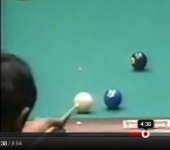Hi all,
interesting thread again
The eye-opener for me was, when someone showed me how precise you can play just using the vertical axis on the cueball. To just vary on the vertical axis including using different speed/acceleration was very impressive for me while seeing it the first time. He showed me kind of *wagon-wheel drill* and i immediatley wanted to start with it- then he also immediatley said: Stop "Fast Eddie" (lol), first you have to understand and master the principles of the tangent-line, then we can start with practicing those things....and in between you should try to get a more repeatable stroke.. From that day on i was infected by the knowledge-virus, hrhr. Remember often that day.
From that day on i was infected by the knowledge-virus, hrhr. Remember often that day.
Since then i try to use almost everytime *the vertical axis*. I m using 5 points as a reference on this vertical axis for my game. If i m forced to use also english, i try to just use that much english as i know exactly what the cb will do while makin 100% sure to make the ball. I am anyway a believer and fan of using natural paths for the CB- makes me feelin good to know what happens and having the control, too.
Hit and hope i really hate
If it s about kicking, then i use of course also several points. 1/2 tip, 1 Tip and 2 tips of english. these 3 points are enough for me, to be able to use the *systems* i usualy use.
lg from overseas,
Ingo
interesting thread again
The eye-opener for me was, when someone showed me how precise you can play just using the vertical axis on the cueball. To just vary on the vertical axis including using different speed/acceleration was very impressive for me while seeing it the first time. He showed me kind of *wagon-wheel drill* and i immediatley wanted to start with it- then he also immediatley said: Stop "Fast Eddie" (lol), first you have to understand and master the principles of the tangent-line, then we can start with practicing those things....and in between you should try to get a more repeatable stroke..
Since then i try to use almost everytime *the vertical axis*. I m using 5 points as a reference on this vertical axis for my game. If i m forced to use also english, i try to just use that much english as i know exactly what the cb will do while makin 100% sure to make the ball. I am anyway a believer and fan of using natural paths for the CB- makes me feelin good to know what happens and having the control, too.
Hit and hope i really hate
If it s about kicking, then i use of course also several points. 1/2 tip, 1 Tip and 2 tips of english. these 3 points are enough for me, to be able to use the *systems* i usualy use.
lg from overseas,
Ingo


